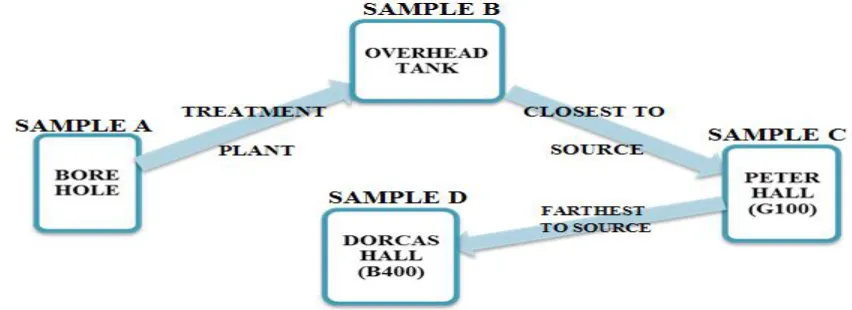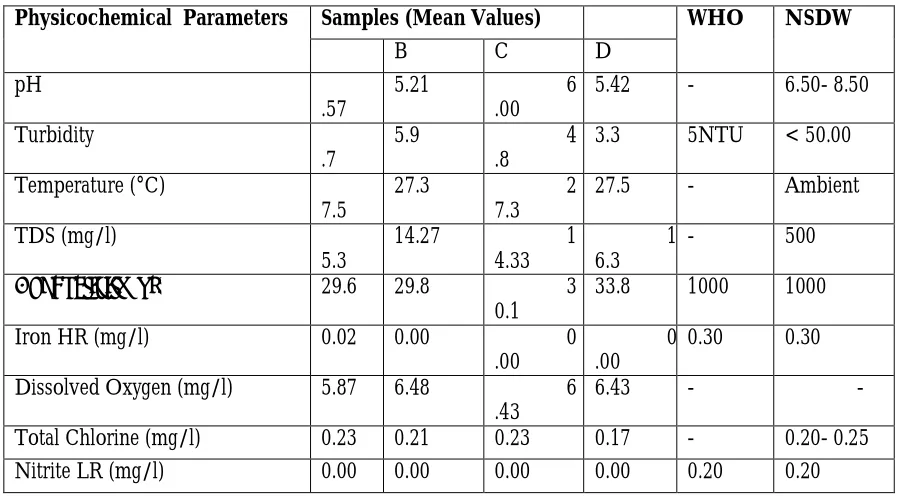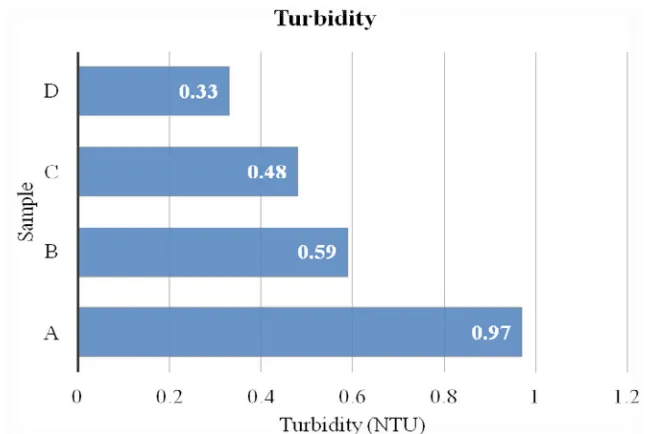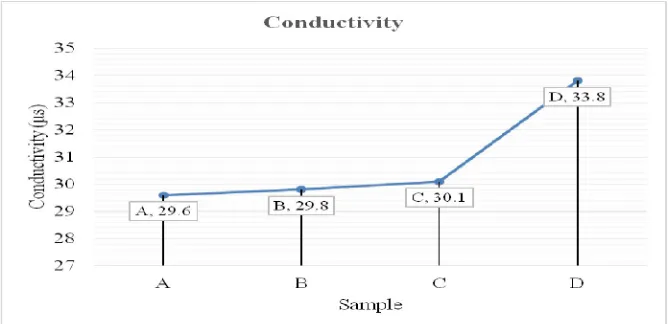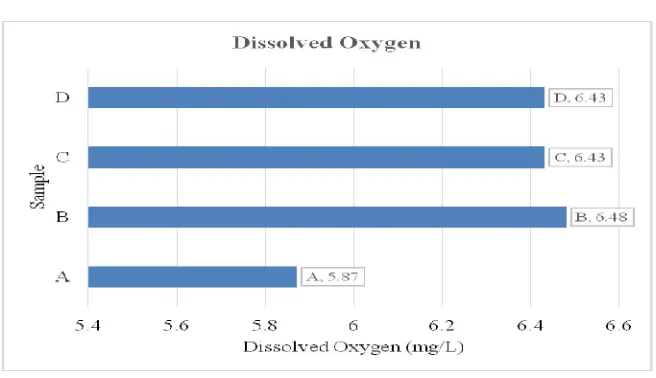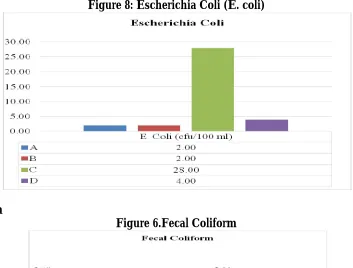ISSN: 2334-2986 (Print), 2334-2994 (Online) Copyright © The Author(s). All Rights Reserved. Published by American Research Institute for Policy Development DOI: 10.15640/jea.v5n1a7 URL: https://doi.org/10.15640/jea.v5n1a7
Assessment of Physio-chemical and Bacteriological Quality of Water Supply for
Domestic Use in Student Hostels in Nigerian University
Ayodeji Olubunmi Ogunde, Tamaraupreye Cynthia Agbeyei, Raphael Ojelabi, James Dele Owolabi & Adedeji Afolabi1*
Abstract
The study examined the consistency in quality of water supply within the student halls of residence in a Nigerian University. The water samples were collected at four different points along the supply chain for three months and both physico-chemical and bacteriological tests were conducted on the samples based on World Health Organization (WHO) and Nigeria Standard for Drinking Water (NSDW) standards concurrently. The results of the physico-chemical test showed that all the samples were within the WHO and NSDW specified permissible range except their pH (4.57-6.00). However, the bacteriological results revealed that the Escherichia Coli (E. coli) of all samples (2, 2, 4 and 28cfu/100ml) were not acceptable. In addition, the fecal coliform results of two samples (0cfu/100ml) were within WHO and NSDW permissible limit values while other samples (1,2 cfu/100ml) were contaminated by some measure of fecal element. Nevertheless, the results of Total Coliform samples of two points were 0&3cfu/100ml therefore within the acceptable limit range but, the remaining two samples points (TNTC) were not acceptable. One of the influences on the result of the bacteriological is the closeness of the water supply pipes to the sewage pipes. In conclusion, bacteriological standard required by both WHO and NSDW was not satisfied in the water supply to the halls of residents. Therefore there is urgent need for the treatment of water supply against the presence of fecal elements to forestall liable diseases for sustainable health.
Keywords: bacteriological test, physico-chemical test, water, nigerian university, WHO, NSDW
1.0 Introduction
Water is an essential resource which forms the basis of life. Life without water will amount to extinction of every form of life on the earth. Water is indispensable for every creature’s survival as there has not been a better substitute for it (Greenhalgh, 2001).World meteorological organization (2012) affirmed that without doubt water is highly essential for human survival. Relevance of water has been since creation and nature has abounded us with high measure of it. According to Igwemadu, Kolawole and Okunloye (2013), water occupies up to seventy (80) percent of the earth in one form or the other which signifies that it is second to no other element. The most valuable commodity in the world today, and likely to remain so for much of this century, is not oil, not natural gas, not even some type of renewable energy, it is water; clean, safe, fresh water (Larry, 2013).
Although natural water is regarded as an abundant artifact on the earth among others, the utility of any water is set by its quality. Ademiluyi and Odugbesan (2008) affirmed that despite the measure of water abound to man by nature, the need for quality water consumption is still a major problem been faced by man. Availability has always been the starting issue before quality comes into play and it is applicable to every sphere of life. Abundance of water to man does not connote adequacy, as adequacy of water is the measure of its utility to man. The availability of fresh water on earth is diminishing and its quality is being compromised. The World Health Organization (2006) states that there are different contaminants in water that may be harmful to human beings, but making sure that the water is free from pathogens that are harmful to the body is of top priority The guidelines set up are not mandatory but they are recommendations to work by (CAWST, 2009).
The scarcity of quality water for man consumption is not a national issue but rather a global one. High density of a population has great impact on the drinking-water quality (UNICEF, 2010). . Antonio (2005) in his findings reveals that more than 1.2 billion populations in the world are still denied access to potable water. The need for potable water according to Population Institute (2010) was as result of its numerous uses which include and not limited to agriculture, industrial for pharmaceutical purpose and most especially for household consumption and so on. Despite the relevance of water to life, it can also be a curse that can cause waterborne disease such as typhoid, cholera, dysentery and so on if its hygiene for human consumption is not being considered. Population institute (2010) revealed that 21 out of 37 major diseases in developing nation have relationship with water. Unsafe water and poor sanitation are the primary causes for the vast majority of water borne and primarily diarrheal diseases.(WHO/UNESCO, 2006). Prasad (2007) established that there is there is a link between potable water and state of health of the populace. Diseases caused as a result of poor water consumption are mostly pandemic and in most case have resulted to colosal loss of lives. Igwemar et.al (2013) revealed that more than 3.4 million lives were lost annually due to contaminable water consumption caused by poor sanitation and affirmed that 99 percent of lives lost as a result of waterborne diseases are from the developing world. Water quality is impeded due to the presence of pollutants such as infectious agents, harmful chemicals, and tomography hazards. Infiltration of contaminants into water is as result of its ability to dissolve contaminable as a good solvent. Proper environmental sanitation is however necessary to control possibilities of water dissolving contaminable thereby altering its quality. Waste processing and discharge of industries into the environment in most developing nations has been a growing concern. Without doubt such waste will eventually find its way back to the system and start terrorizing human health. Water being a good dissolving agent, it is highly susceptible to such discharge polluting our environment. Due to such unhealthy practice, there is a need to monitor quality water consistently as to ensure its sustainability has not been compromised.
This study aimed at assessing the consistency in quality of water supply for students’ consumption at Covenant University as to forestall liable diseases related to water within the community.
2.0 Materials and Methods
2.1 Study Area:
Covenant University is a private Christian University situated in Ota Local government in Ogun state, Nigeria. The university land mass area is above 300 hectares and it is well abound with green vegetation. The structure of buildings within the university was stratified into administrative buildings, staff residential building and students’ halls of residence. The student halls of residence accommodates up to seven thousands students. It has 5 male hostels and five female hostels.
2.2 Samples Collection:
Water samples were collected from four different points for the study within the students’ halls of resident and the samples were labeled ‘A’ to ‘D’. Samples were collected in triplicate on a monthly basis for a period of 3 months. Sample A water was taken from the borehole location before treatment, sample B was taken from the storage tank after the water has been treated, sample C was taken from Peter hall, the nearest hostel to the supply of water and sample D was taken from Dorcas hostel and it is the farthest point of water supply within the students hostels as shown in figure1.
Figure 1: Illustration to Show Linear Connectivity between Sample Collection Points.
For physico-chemical analysis, properly labeled 2L plastic containers were used to collect three water samples each from the four locations over a period of 3 months. Prior to collection, the containers were washed with 5%HCI and left to dry for twenty-four (24) hours.
For bacteriological analysis, the methodology used by our research laboratory is the membrane filter technique. Samples were collected in plastic containers which have been sterilized in an autoclave at
1210C for 30min. and treated with a small amount of sodium thiosulphate to remove any chlorine present.
2.3 Laboratory sites:
The physico-chemical analysis was done in the Chemistry laboratory of Covenant University while the bacteriological analysis was done in Aquadril Laboratory and Environmental Services, Agege, Lagos.
3.0 Result and Discussion
3.1 Physico-Chemical Analysis:
Physico-chemical analysis was carried out and the result was subjected to the standard of World Health Organization (WHO) and Nigeria Standard of Drinking Water (NSDC) concurrently. The result obtained from the experiment was presented in tab
Table 1: Physico-chemical Result being compared with WHO and NSDW standards
Physicochemical Parameters Samples (Mean Values) WHO NSDW
B C D
pH
.57
5.21 6
.00
5.42 - 6.50- 8.50
Turbidity
.7
5.9 4
.8
3.3 5NTU < 50.00
Temperature (°C)
7.5
27.3 2
7.3
27.5 - Ambient
TDS (mg/l)
5.3
14.27 1
4.33
1 6.3
- 500
Conductivity (µs) 29.6 29.8 3
0.1
33.8 1000 1000
Iron HR (mg/l) 0.02 0.00 0
.00
0 .00
0.30 0.30
Dissolved Oxygen (mg/l) 5.87 6.48 6
.43
6.43 - -
Total Chlorine (mg/l) 0.23 0.21 0.23 0.17 - 0.20- 0.25
Nitrite LR (mg/l) 0.00 0.00 0.00 0.00 0.20 0.20
3.1.1 Potential of Hydrogen (pH)
Figure 2 Potential of Hydrogen
3.1.2 Turbidity
Figure 3 Turbidity
WHO (1983, has standard value (5NTU) for turbidity but NSDW permits turbidity to be less than
five Nephelometric Turbidity Units (5 NTU/ 50µs/cm). Table 1and figure 3 shows that all samples (A to
D) ranging from 0.33-0.97NTU/ 3.3-9.7µs/cm falls within the permissible standard. Hence the water
3.1.3 Total Dissolved Solids
Figure 4. Total Dissolved Solids
The World Health Organization (WHO) has no standard limit value for total dissolved solids however, the Nigerian Standard of Drinking Water (NSDW) permits a maximum of 500mg/l. Table 1 and figure 4 shows that all samples (A to D) ranges from 14.27-16.3mg/L are within the maximum level permitted by NSDW. Therefore, the portability of the water at all points is safe with respect to total dissolve solid. Total dissolved solids (TDS) are made up of inorganic salts (mainly sodium chloride, calcium, magnesium, and potassium) and small amounts of organic matter that are dissolved in water. Too high TDS can cause a bitter or salty taste while extremely low TDS has a flat taste. A Hanna HI 9835 Microprocessor Conductivity/TDS meter was used to determine the conductivity and TDS of the water samples.
3.1.4 Conductivity
The World Health Organization and the Nigerian Standard of Drinking Water permits a maximum
of 1000µs. Table 1 shows that all samples (A to D) ranges from 29.6 – 33.8µs/cm are within the maximum
level permitted by the WHO and NSDW. Therefore the water supplied with respect to conductivity is safe. Conductivity is defined as the ability of a substance to conduct or transmit electricity.
3.1.5 Iron
The dissolved iron in all the water samples are within the specified permissible value of 0.30mg/L of iron as given by WHO and NSDW. The dissolve iron in the water across all points ranges from 0.00-0.02mg/l of iron. As such, the portability of the water has not been compromised with respect to dissolved iron. A Hanna HI 9835 Microprocessor Conductivity/TDS meter was used to determine the conductivity and TDS of the water samples.
3.1.6 Dissolved Oxygen
Figure 6: Dissolved Oxygen
The dissolved oxygen and temperature are within WHO and NSDW standards
3.1.6 Total Chlorine
The World Health Organization (WHO) has no standard value for chlorine. The Nigerian Standard of Drinking Water (NSDW) permits free residual chlorine maximum levels of 0.2-0.25. Table 1 shows that all samples (A to D) ranged from 0.17-0.23 is less than the maximum levels permitted by the NSDW, hence the chlorine level of the samples at all point is safe.
3.1.7 Nitrate
The World Health Organization and the Nigerian Standard of Drinking Water permits a maximum of 0.20 in potable water. Table 1 shows that all samples (A to D) are 0 which is below the maximum permissible standard. Therefore the water supplied is safe with respect to nitrite.
3.0 Results and Analyses of Bacteriological Analysis
4.1 Escherichia Coli (E. coli)
The standard requirement for both WHO and NSDW is zero coli form unit per hundred millilitre (0 cfu/100ml) for E. coli. Figure 5 shows that all samples were above the standard. Sample C had the highest count with 28cfu/100ml. Sample D was less with 4cfu/100ml. Sample A and B had 2cfu/ml. This indicates the possible presence of faecal contamination.
Figure 8: Escherichia Coli (E. coli)
4.2 Fecal Coliform
Figure 6.Fecal Coliform
4.3 Bacteriological Analysis
The bacteriological experiment was performed on the water samples taken at four (4) points over a period of three months and the results were equally subjected to WHO and NSDW standard. The result obtained is presented in table 2.
Table 2.0: Bacteriological Result being compared with WHO and NSDW standards
Bacteriological Parameters Samples (mean values} WHO NSDW
A B C D
E. coli (cfu/100 ml) 2.00 0.00 28.00 4.00 0 0
Fecal Coliform (cfu/100 ml) 0.00 0.00 2.00 1.00 0 0
Total Coliform (cfu/100 ml) 3.00 0.00 TNTC TNTC 0-10 10
Table 2 shows that E. coli for water samples ‘A’, ‘C’ and ‘D’ did not meet the maximum required standard (0cfu/100 ml) of WHO and NSDW for potable water, however sample B is in consonance with the permissible limit set. Fecal Coliform for samples ‘A’ and ‘B’ met the requirement but samples ‘C’ and ‘D’ did not meet the requirement because they are above (0cfu/100 ml) . Total coliform for samples A and B are seen to be within the possible minimum required standard. Sample C and D are too numerous to count (TNTC). This implies that they are heavily contaminated with faecal matter. This result implies the presence of fecal contamination and other bacterial entities (pathogens). One of the influences on the result of the bacteriological is the closeness of the water supply pipes to the sewage pipes.
4.0 Conclusion
References
Ademiluyi, I.A., and Odugbesan, J.A.,(2008). Sustainability and impact of community water supply and sanitation programs in Nigeria: An overview. African journal of agriculture research, 3(12) 811-817.
Antonio, I.A., (2005). The European response to the challenges of water sanitation in developing counties, in TRIBUNE, the document of European commission.
Centre for affordable water and sanitation technology (CAWST), (2009): Introduction to drinking water quality testing. A CAWST training manual, June Edition.
Greenhalgh, Alison (March 2001). Healthy living - Water. BBC Health. Accessed on18th April, 2014.
Heron, S.F., (2012). Heron, S.F., (2012). Natural Sources of Water. http://www.ehow.com/about _5371 945natural-sources-water.html#izz2QUcey6fk Accessed on 13th April, 2014
Igwemmar, N.C., Kolawole, S.A., and Okunoye, S.A., (2013). Physical and chemical assessment of some selected borehole water in Gwagwalada, Abuja. International journal of scientific and technology research, 2(11) 324-328.
Larry W., (2013). Water now More Valuable than Oil. (http://environment.about.com/od/ global warming/a/waterinvesting.htm) Accessed on 13th April, 2014
Nigeria Standard for Drinking Water Quality (NSDWQ) (2007): Approved by standard organisation of Nigeria governing council.
Okoli, G.C., Njoku, N.A., Njoku, P.C., Njoku, J.D., Dike, M.U., & Ojiegbe, R.U., (2005). Quality characteristics of groundwater utilized by resident students of a Nigerian University. Journal of Applied Sciences 5(6), 1088-1091.
Perlman, H., (2013). Perlman, H., (2013). Water, the Universal Solvent. http://ga.water.usgs.gov/edu/solvent.html Accessed on April, 2014.
Population Institute (2010). Population and water
(available at www.populationinstitute.org/external/files/fact_sheets/water_and_population.pdf)
Prasad, N., (2007). Privatization of water: A historical perspective. Law, Environment and Development Journal, 3(2) 811-817.
UNICEF/ WHO. (2004). Meeting the MDG drinking water and sanitation target - A midterm assessment of progress: United Nations Children's Fund and World Health
Organisation, pp. 36
UNICEF./ WHO (2006). Meeting the MDG drinking water and sanitation target , Theurban and rural challenge of the decade. World Health Organisation and United Nations Children's Fund, pp. 41.
United Nations Development Programme, (UNDP). (2006). Human Development Report 2006, Beyond Scarcity: Power, Poverty and the Global Water Crisis.
World Health Ogarnisation (2000). Global Water Supply and Sanitation Assessment Report, World Health Organisation-United Nations Children Fund, Geneva, Switzerland.
World Health Organization, (WHO). (2008). Safer Water, Better Health: Costs, benefits, and sustainability of interventions to protect and promote health
World Health Organization (2013). Water Health Topics. http://www.who.int/topics/water/en/ (April, 2014). World Health Organization (1983), Guidelines for Drinking Water Quality. World Health Organisation, Geneva,
Switzerland.
World Health Organization (2014). Guidelines for Drinking water Quality, 2nd edition. World Health Geneva,
23-233.
